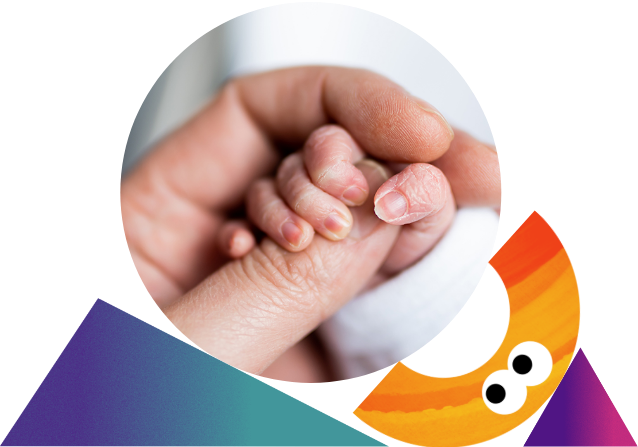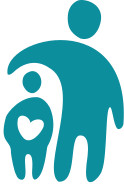Pathway for parents or carers of babies aged 0 to 6 months who have experienced neonatal care
Join our learning pathway for all parents, grandparents and carers of babies who have experienced neonatal care: a journey of understanding your preterm or sick baby now you’re home.
Pathway stages
Bitesize stages for daily steps towards confident parenting and connected relationships.
1. Welcome
1.1 Welcome
1.2 This course
1.3 A few questions
1.4 National resources for you
1.5 Local resources for you
1.6 What’s next
2. Staying in at home (after discharge)
2.1 Adjusting to being at home
2.2 Looking back on your neonatal journey so far
2.3 Regrowing your safety bubble
3. Understanding your baby’s brain
3.1 Baby brain development
3.2 You and your baby’s brain
3.3 Feeding, the brain and your relationship
3.4 The lookaway
4. Understanding your baby’s crying
4.1 Introduction
4.2 Crying
4.3 What do babies communicate?
4.4 How do babies communicate?
4.5 Views on crying
4.6 Is it true? You can spoil a baby by picking him up too much when he cries?
4.7 Is it True? Babies need to cry as it’s good for their lungs
4.8 Is it True? Leaving a baby to cry will teach them to comfort themselves
4.9 Is it True? You should never leave a baby to cry
4.10 Is it True? Parents are biologically designed to want to respond to their baby’s cries
4.11 Is it True? Crying is an instinct; a baby hopes someone will respond to them
4.12 Recap and Home activity
5. How to respond to crying
5.1 Introduction and Home Activity
5.2 Responding to crying
5.3 Dealing with not knowing
5.4 Why some babies cry more than others
5.5 Crying due to pain such as colic, reflux or birth trauma
5.6 What might affect how a parent responds to crying?
5.7 Why does how a parent feels affect their response to crying?
5.8 Recap and Home Activity
6. Understanding your baby’s rhythms
6.1 Introduction and Home Activity
6.2 Getting to know your baby’s rhythms
6.3 Introducing the dance of reciprocity
6.4 The Dance of Reciprocity
6.5 Video of the Dance of Reciprocity
6.6 Rupture and repair
6.7 Home Activity: Observe the ‘dance of reciprocity’
7. Developing healthy sleep patterns
7.1 Introduction and Home Activity
7.2 Helping babies to develop healthy sleep patterns
7.3 Why is sleep important for a baby?
7.4 How long should a baby sleep?
7.5 What helps you get to sleep?
7.6 What helps your baby get to sleep?
7.7 Where should babies sleep?
7.8 Crying and sleep
7.9 Home Activity: One new thing
8. Understanding your baby’s feeding
8.1 Introduction and Home Activity
8.2 Your baby’s feeding pattern and cues
8.3 How is your baby’s feeding pattern changing?
8.4 Mealtime memories
8.5 Feeding with a tube survey attached
8.6 Home activity: Something that’s new in your baby’s development
9. Who’s the Daddy, I’m the Daddy!
9.1 Welcome!
9.2 Father’s time with baby
9.3 The importance of dads
9.4 Understanding your feelings after the birth
9.5 Fathers and breastfeeding
9.6 Breastfeeding: coping with other peoples’ opinions
9.7 Getting used to the change
9.8 Who wants to play?!
9.9 Recap
10. I’m the partner!
10.1 Welcome!
10.2 Your time with the baby
10.3 You and breastfeeding
10.4 Coping with other peoples’ opinions
10.5 Recap
11. Understanding your baby’s development and play
11.1 Introduction and Home Activity
11.2 Emotional and physical development
11.3 Gestational age
11.4 Emotional development
11.5 The first three months
11.6 Three to nine months
11.7 Nine to twelve months
11.8 Supporting your baby’s emotional and physical milestones
11.9 Play
11.10 Home activity: Playing with your baby
12. Understanding your baby’s childcare
12.1 Introduction
12.2 Feedback from the home activity: playing with your baby
12.3 Other people looking after your baby
12.4 Choosing childcare: Nurseries
12.5 Choosing childcare: Childminders
12.6 Choosing childcare: Family and friends
12.7 Recap
13. Understanding your baby’s development and play
13.1 Congratulations!
13.2 A few questions
13.3 Acknowledgements
About this pathway
Having a preterm or sick baby cared for in a hospital can be an overwhelming experience, where parents experience uncertainties, fear and stress. This pathway is designed to help you learn about your baby’s development, understand their needs and read their cues, but also to support your emotional wellbeing.
This pathway has been developed by our team of experts, including clinical psychologists, child psychotherapists, healthcare professionals and, most importantly, parents just like you. It is designed to help you develop a strong and connected relationship with your baby, including both practical information about caring for your baby as well as information about their developmental needs and guidance for feeding, sleeping and crying.
Everything you will learn in the course has been informed by experience and is designed to be practical, to help you and your family navigate this time at home after leaving neonatal care.
Along this pathway, created with Dr Davy Evans, a consultant clinical psychologist and neonatal specialist, you will explore:
- Understanding baby brain development in neonatal care
- How to recognise cues for comfort, bonding, and sleep
- Feeding
- Safe sleeping
- Building confidence in soothing and caring for your baby
We know this might not be the journey you expected, but you are not alone. We’re here to support you through it, one step at a time.
92% learners said they found the pathway helpful
92% learners said they would recommend the pathway to friends and family
92% of learners who completed the pathway said that it made a difference for them
“I am learning new skills about child development and interaction with my children and how the brain develops from in the womb.”
Parent from the pathway
“I have learned so many new things about my baby, the pathway is really helpful.”
Parent from the pathway
“Great to know how to take proactive approaches to ensure our baby is looked after.”
Parent from the pathway
“As a foster carer who helps a lot of babies, I found this pathway very useful to top my knowledge off and to keep up with the milestones.”
Learner from the pathway



